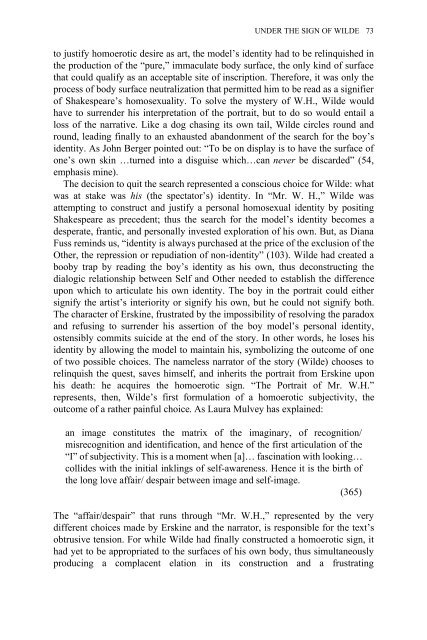Edited by Moe Meyer - Get a Free Blog
Edited by Moe Meyer - Get a Free Blog
Edited by Moe Meyer - Get a Free Blog
Create successful ePaper yourself
Turn your PDF publications into a flip-book with our unique Google optimized e-Paper software.
UNDER THE SIGN OF WILDE 73<br />
to justify homoerotic desire as art, the model’s identity had to be relinquished in<br />
the production of the “pure,” immaculate body surface, the only kind of surface<br />
that could qualify as an acceptable site of inscription. Therefore, it was only the<br />
process of body surface neutralization that permitted him to be read as a signifier<br />
of Shakespeare’s homosexuality. To solve the mystery of W.H., Wilde would<br />
have to surrender his interpretation of the portrait, but to do so would entail a<br />
loss of the narrative. Like a dog chasing its own tail, Wilde circles round and<br />
round, leading finally to an exhausted abandonment of the search for the boy’s<br />
identity. As John Berger pointed out: “To be on display is to have the surface of<br />
one’s own skin …turned into a disguise which…can never be discarded” (54,<br />
emphasis mine).<br />
The decision to quit the search represented a conscious choice for Wilde: what<br />
was at stake was his (the spectator’s) identity. In “Mr. W. H.,” Wilde was<br />
attempting to construct and justify a personal homosexual identity <strong>by</strong> positing<br />
Shakespeare as precedent; thus the search for the model’s identity becomes a<br />
desperate, frantic, and personally invested exploration of his own. But, as Diana<br />
Fuss reminds us, “identity is always purchased at the price of the exclusion of the<br />
Other, the repression or repudiation of non-identity” (103). Wilde had created a<br />
boo<strong>by</strong> trap <strong>by</strong> reading the boy’s identity as his own, thus deconstructing the<br />
dialogic relationship between Self and Other needed to establish the difference<br />
upon which to articulate his own identity. The boy in the portrait could either<br />
signify the artist’s interiority or signify his own, but he could not signify both.<br />
The character of Erskine, frustrated <strong>by</strong> the impossibility of resolving the paradox<br />
and refusing to surrender his assertion of the boy model’s personal identity,<br />
ostensibly commits suicide at the end of the story. In other words, he loses his<br />
identity <strong>by</strong> allowing the model to maintain his, symbolizing the outcome of one<br />
of two possible choices. The nameless narrator of the story (Wilde) chooses to<br />
relinquish the quest, saves himself, and inherits the portrait from Erskine upon<br />
his death: he acquires the homoerotic sign. “The Portrait of Mr. W.H.”<br />
represents, then, Wilde’s first formulation of a homoerotic subjectivity, the<br />
outcome of a rather painful choice. As Laura Mulvey has explained:<br />
an image constitutes the matrix of the imaginary, of recognition/<br />
misrecognition and identification, and hence of the first articulation of the<br />
“I” of subjectivity. This is a moment when [a]… fascination with looking…<br />
collides with the initial inklings of self-awareness. Hence it is the birth of<br />
the long love affair/ despair between image and self-image.<br />
(365)<br />
The “affair/despair” that runs through “Mr. W.H.,” represented <strong>by</strong> the very<br />
different choices made <strong>by</strong> Erskine and the narrator, is responsible for the text’s<br />
obtrusive tension. For while Wilde had finally constructed a homoerotic sign, it<br />
had yet to be appropriated to the surfaces of his own body, thus simultaneously<br />
producing a complacent elation in its construction and a frustrating


